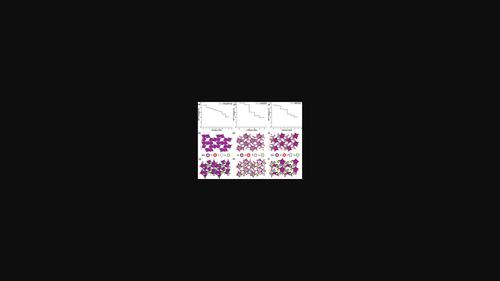当前位置:
X-MOL 学术
›
Adv. Theory Simul.
›
论文详情
Our official English website, www.x-mol.net, welcomes your feedback! (Note: you will need to create a separate account there.)
Unconstrained Machine Learning Screening for New Li-Ion Cathode Materials Enhanced by Class Balancing
Advanced Theory and Simulations ( IF 3.3 ) Pub Date : 2023-04-14 , DOI: 10.1002/adts.202300081 Filip Dinic 1, 2 , Oleksandr Voznyy 1, 2
Advanced Theory and Simulations ( IF 3.3 ) Pub Date : 2023-04-14 , DOI: 10.1002/adts.202300081 Filip Dinic 1, 2 , Oleksandr Voznyy 1, 2
Affiliation

|
Modeling and predicting battery cathode material voltage requires accurate structural information regarding the binding sites of lithium within a target structure. Obtaining these optimized structures requires some form of structural optimization. The ensuing complexity impedes the rapid screening of new materials for their suitability in energy storage. Previous machine learning (ML) models use structures of both lithiated and nonlithiated forms for training; essentially, reproducing what is already known, but failing to generalize to structures whose lithiated form is not available. To avoid this limitation, an ML model capable of predicting the voltage associated with the material's lithiation without explicitly requiring the lithiated structure is trained. The model's predictive power is improved by adding newly calculated data points, with the most impactful being materials with unfavorable Li binding, which are lacking in the original dataset. Using this model, new cathode candidates among an order of magnitude more materials than in previous studies are screened and the most promising ones are validated with density functional theory calculations. Considering additional stability and conductivity constraints, 572 materials with voltages greater than 3.5 V are predicted. Unexpectedly, some of them are not based on conventional transition metals, highlighting the power of an unbiased search.
中文翻译:

通过类平衡增强新型锂离子正极材料的无约束机器学习筛选
建模和预测电池阴极材料电压需要有关目标结构内锂结合位点的准确结构信息。获得这些优化的结构需要某种形式的结构优化。随之而来的复杂性阻碍了新材料在储能方面的适用性的快速筛选。以前的机器学习(ML)模型使用锂化和非锂化形式的结构进行训练;本质上,复制了已知的东西,但未能推广到锂化形式不可用的结构。为了避免这种限制,我们训练了一个机器学习模型,该模型能够预测与材料锂化相关的电压,而无需明确要求锂化结构。通过添加新计算的数据点来提高模型的预测能力,最有影响力的是具有不利的锂结合的材料,而原始数据集中缺乏这些材料。使用该模型,可以从比以前的研究多一个数量级的材料中筛选新的阴极候选材料,并通过密度泛函理论计算验证最有前途的材料。考虑到额外的稳定性和电导率限制,预计有 572 种材料的电压大于 3.5 V。出乎意料的是,其中一些并不是基于传统的过渡金属,这凸显了公正搜索的力量。在比以前的研究多一个数量级的材料中筛选出新的阴极候选材料,并通过密度泛函理论计算验证最有前途的材料。考虑到额外的稳定性和电导率限制,预计有 572 种材料的电压大于 3.5 V。出乎意料的是,其中一些并不是基于传统的过渡金属,这凸显了公正搜索的力量。在比以前的研究多一个数量级的材料中筛选出新的阴极候选材料,并通过密度泛函理论计算验证最有前途的材料。考虑到额外的稳定性和电导率限制,预计有 572 种材料的电压大于 3.5 V。出乎意料的是,其中一些并不是基于传统的过渡金属,这凸显了公正搜索的力量。
更新日期:2023-04-14
中文翻译:

通过类平衡增强新型锂离子正极材料的无约束机器学习筛选
建模和预测电池阴极材料电压需要有关目标结构内锂结合位点的准确结构信息。获得这些优化的结构需要某种形式的结构优化。随之而来的复杂性阻碍了新材料在储能方面的适用性的快速筛选。以前的机器学习(ML)模型使用锂化和非锂化形式的结构进行训练;本质上,复制了已知的东西,但未能推广到锂化形式不可用的结构。为了避免这种限制,我们训练了一个机器学习模型,该模型能够预测与材料锂化相关的电压,而无需明确要求锂化结构。通过添加新计算的数据点来提高模型的预测能力,最有影响力的是具有不利的锂结合的材料,而原始数据集中缺乏这些材料。使用该模型,可以从比以前的研究多一个数量级的材料中筛选新的阴极候选材料,并通过密度泛函理论计算验证最有前途的材料。考虑到额外的稳定性和电导率限制,预计有 572 种材料的电压大于 3.5 V。出乎意料的是,其中一些并不是基于传统的过渡金属,这凸显了公正搜索的力量。在比以前的研究多一个数量级的材料中筛选出新的阴极候选材料,并通过密度泛函理论计算验证最有前途的材料。考虑到额外的稳定性和电导率限制,预计有 572 种材料的电压大于 3.5 V。出乎意料的是,其中一些并不是基于传统的过渡金属,这凸显了公正搜索的力量。在比以前的研究多一个数量级的材料中筛选出新的阴极候选材料,并通过密度泛函理论计算验证最有前途的材料。考虑到额外的稳定性和电导率限制,预计有 572 种材料的电压大于 3.5 V。出乎意料的是,其中一些并不是基于传统的过渡金属,这凸显了公正搜索的力量。


























 京公网安备 11010802027423号
京公网安备 11010802027423号